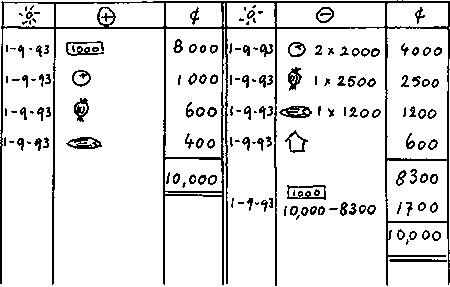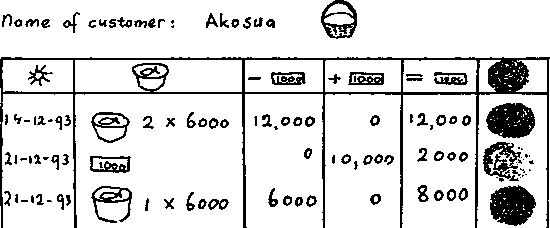Objective:
To show people how to stay in control of money by writing down what they have spent and what they have received. Memory is not good enough when trying to make a profit.
Method:
Teach people some simple methods of keeping financial records and encourage their use whenever possible. Use the examples given below.
Example 1: this is a simple cash book layout in which symbols have been used instead of words. It is taken from Simple Book-keeping and Business Management Skills (FAO).

This cash book belongs to Elizabeth who sells tomatoes, onions and okra in the market.
On this particular day, she starts with 8,000 cash in hand.
In the morning she buys:
2 baskets of tomatoes at 2,000 each
1 bag of onions at 2,500
1 basket of okra at 1,200
During the day, she sells: tomatoes for 1,000
onions for 600
and okra for 400
She also takes 600 for herself to buy food for the household.
At the end of the day she has 1,700 left in cash. So her cash book for the next day will start with 1,700 cash in hand.
Example 2: this is a more advanced type of cash book in which receipts and expenditure are noted down under separate headings for each type of enterprise or type of commodity. It is called an “analysed” cash book.
Here is an extract from a receipts page of an analysed cash book.
|
Date |
Details |
Total |
Maize |
Yams |
Fish |
Poultry |
Wages |
Cooked |
|
2/2 |
Crops sold at market |
1,050 |
|
1,050 |
|
|
|
|
|
5/2 |
Eggs sold at market |
1,480 |
|
|
|
1,480 |
|
|
|
10/2 |
Casual work for Joseph |
|
|
|
|
|
2,500 |
|
|
15/2 |
Crops / food sold at market |
1,820 |
1,020 |
|
|
|
|
800 |
|
19/2 |
Fish sold to trader |
1,500 |
|
|
1,500 |
|
|
|
|
|
|
|
|
|
|
|
|
|
Learning to use an analysed cash book opens up the possibility of monitoring budgets more closely. Having made a plan and implemented it, taking the time to compare what has actually been bought and spent with what was predicted to be bought and spent is invaluable. Instead of sliding into ruin because major discrepancies were not noticed, the person who monitors cash inflow and outflow is more able to predict problems and take avoiding action.
Example 3: monitoring a cash flow budget.
|
RECEIPTS |
Budget |
Actual |
Budget |
Actual |
etc |
|
Fish |
7,500 |
9,200 |
|
|
|
|
Groundnuts |
|
|
20,000 |
21,256 |
|
|
Rice |
30,000 |
23,670 |
|
8,410 |
|
|
Cooked food |
12,000 |
9,830 |
12,000 |
10,580 |
|
|
|
|
|
|
|
|
If someone has a cash flow budget, he or she can fill in a second copy of the form recording actual receipts and purchases as they occur without even keeping a cash book.
Example 4: recording credit transactions. Trading activities are often accompanied by the problem of managing debts. If goods are sold to customers on credit, a credit book should be kept with a record for each customer. By recording the value of goods supplied on credit and amounts paid back, the recovery of money owed can be controlled. Here is an example from Simple Book-keeping and Business Management Skills.
